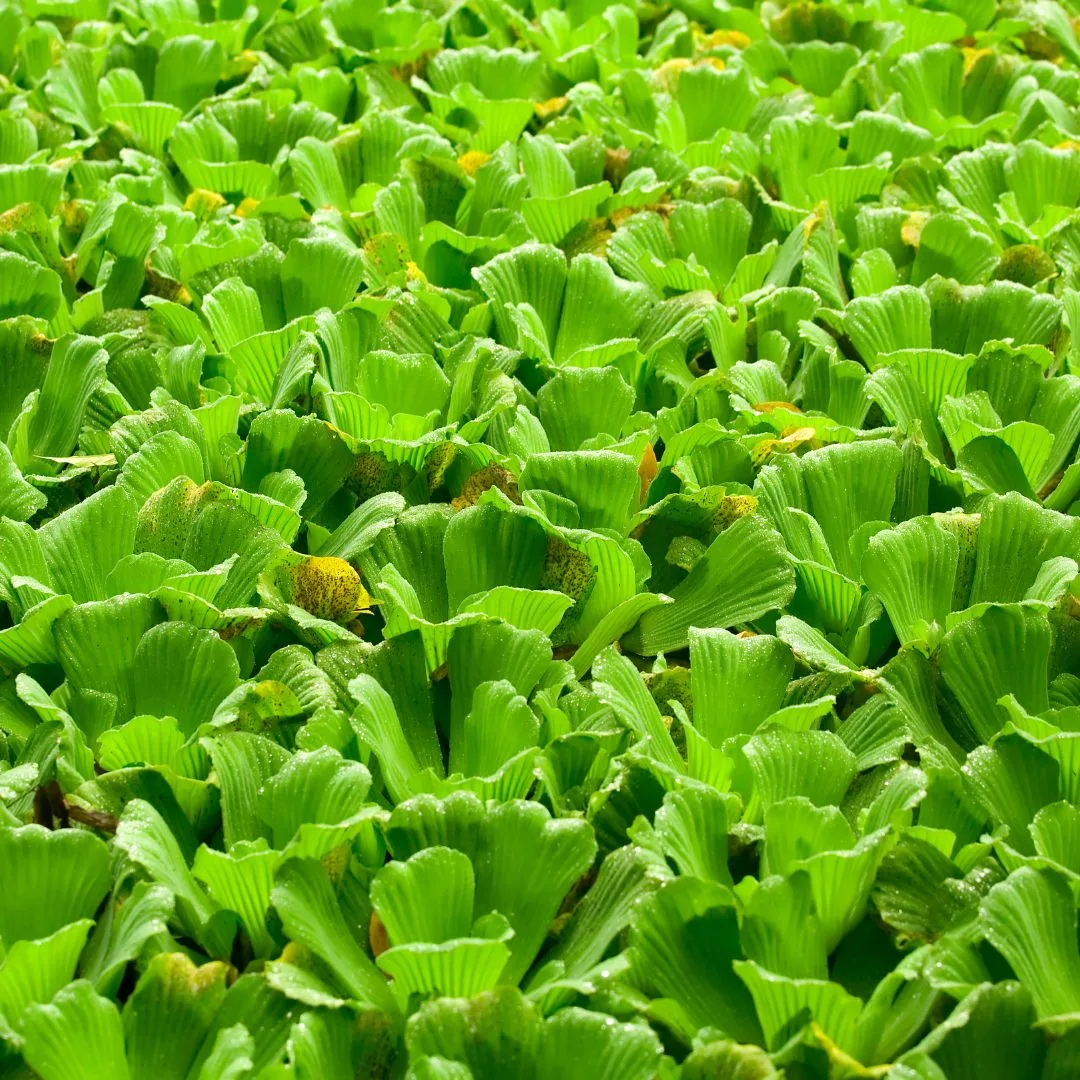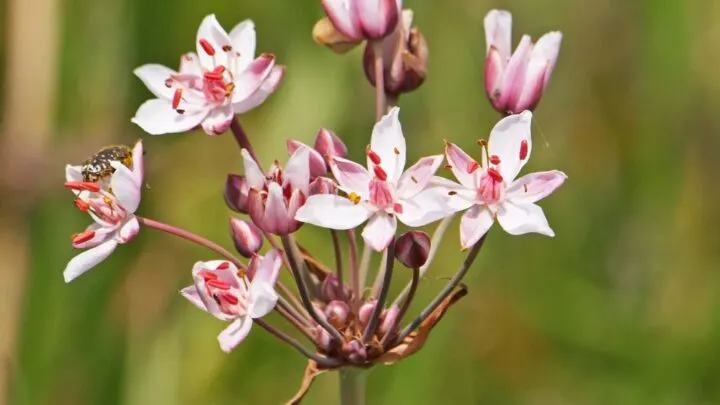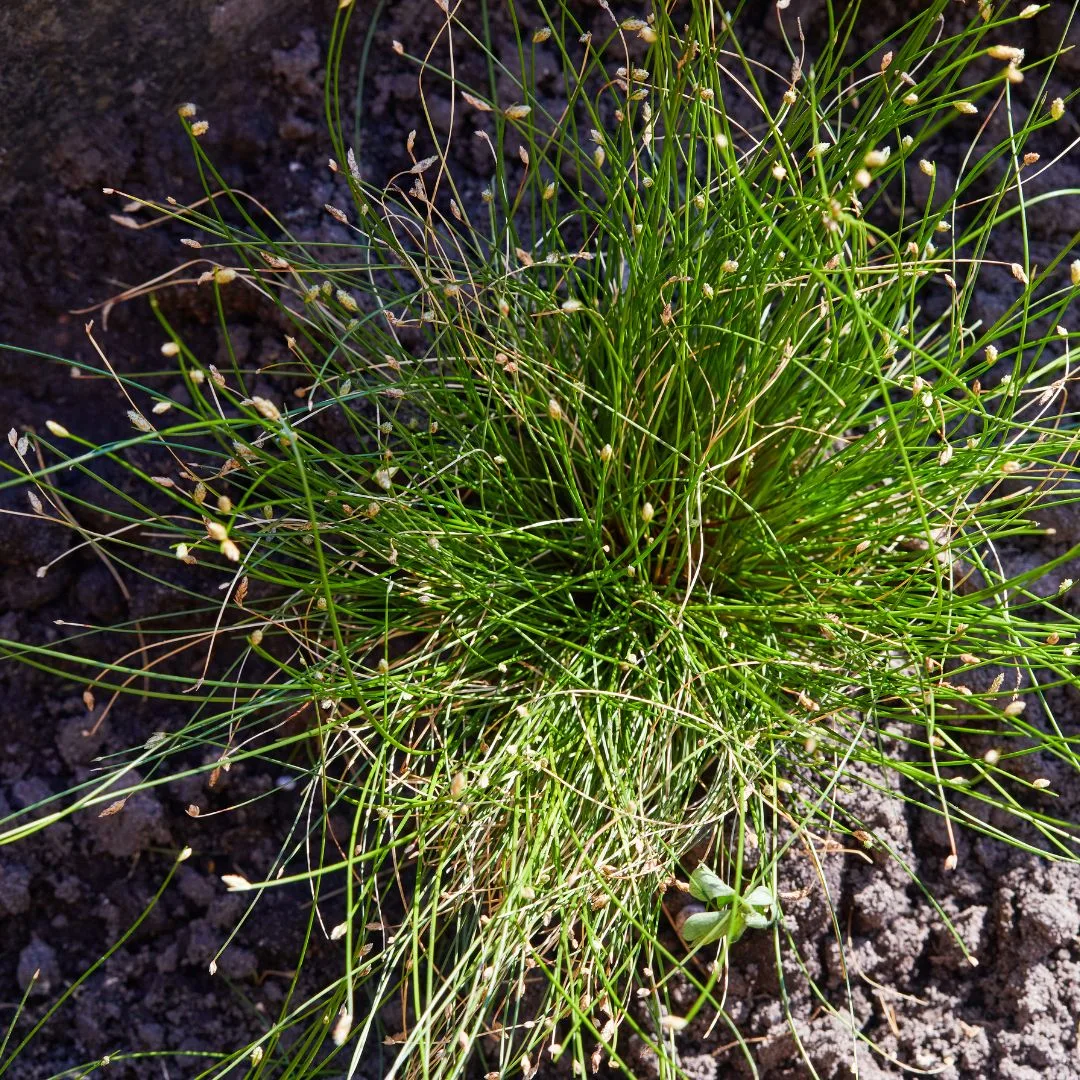There are three different types of plants that you can grow in ponds: plants that are fully submerged, plants that float on the surface, and plants that grow around the edge. They are useful for providing shelter for aquatic wildlife, and keeping the water clear and oxygenated. This post lists 31 plants for a healthy pond.
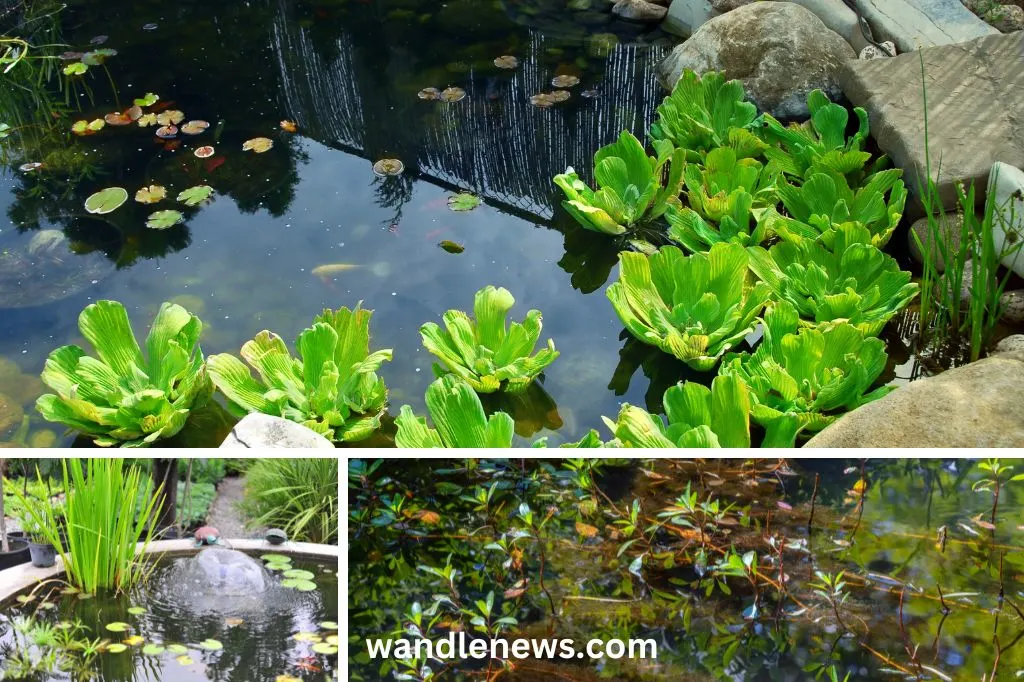
31 Great Plants for Ponds
Ponds offer a tranquil oasis within your garden, and the right choice of aquatic plants can elevate their beauty and functionality. Whether submerged, floating, or adorning the edges, these plants contribute to a balanced ecosystem, providing shelter for aquatic life and promoting water clarity and oxygenation.
Explore my selection of 31 pond plants to create a captivating aquatic haven:
Water Hyacinth (Eichhornia crassipes)
- Vibrant lavender-blue flowers make a stunning display.
- Known for their ability to absorb excess nutrients from the water.
Water Lettuce (Pistia stratiotes)
- Delicate rosettes of pale green leaves provide shade for pond inhabitants.
- Ideal for controlling algae growth.
Cardinal Flower (Lobelia cardinalis)
- Striking red blooms on tall stalks add a splash of colour.
- Attracts butterflies and hummingbirds.
Flowering Rush (Butomus umbellatus)
- Pink blooms clustered atop tall stems create a captivating focal point.
- Flourishes in shallow waters.
Corkscrew Rush (Juncus effusus 'Spiralis')
- Uniquely twisted foliage adds texture and interest.
- Suitable for both submerged and marginal planting.
Marsh Marigold (Caltha palustris)
- Bright yellow blooms herald the arrival of spring.
- Thrives at the water's edge, providing a splash of colour.
Bowles' Golden Sedge (Carex elata 'Aurea')
- Golden foliage adds a touch of elegance to the pond's margins.
- Offers erosion control and habitat for insects.
Egyptian Paper Reed (Cyperus papyrus)
- Towering umbrella-like clusters of thin stems make a bold statement.
- Adds a touch of the exotic to your pond.
Houttuynia cordata 'Chameleon'
- Multicoloured leaves create a visual spectacle.
- Spreading habit provides ground cover.
Yellow Iris (Iris pseudacorus)
- Sword-like leaves and striking yellow flowers create a dramatic effect.
- Removes excess nutrients from the water.
Purple Loosestrife (Lythrum salicaria)
- Tall spikes of purple-pink flowers create a stunning vertical display.
- Thrives in moist soil along pond edges.
- Attracts pollinators like bees and butterflies.
- Note: Purple Loosestrife can be invasive in some regions, so check before planting.
Golden Club (Orontium aquaticum)
- Unique yellow flower spikes emerge from underwater.
- Adds an element of surprise to your pond's ecosystem.
Pickerel Weed (Pontederia cordata)
- Heart-shaped leaves and spikes of blue-violet flowers create a picturesque scene.
- Flourishes in shallow water and provides habitat for aquatic creatures.
- Adds vertical interest and a pop of colour to your pond's margins.
Hornwort (Ceratophyllum demersum)
- Oxygenating plant that helps maintain water clarity.
- Provides hiding places for young fish.
Greater Water-moss (Spirodela polyrhiza)
- Small, floating plants resemble a delicate moss carpet.
- Provides shade for fish and helps maintain water quality.
Water Violet (Hottonia palustris)
- Delicate violet flowers add an air of elegance.
- Flourishes in calm, shaded waters.
Slender Club Rush (Isolepis cernua)
- Slender, arching stems with clusters of tiny brownish flower spikes.
- Adds a delicate and graceful touch to the edges of your pond.
- Thrives in moist soil or shallow water.
- Provides a natural habitat for small aquatic creatures.
Spiked Water Milfoil (Myriophyllum spicatum)
- Feather-like leaves provide shelter and spawning grounds for fish.
- Enhances water quality by absorbing nutrients.
Curly Pondweed (Potamogeton crispus)
- Submerged leaves create a refuge for small aquatic creatures.
- Adds oxygen to the water and reduces algae growth.
Water Crowfoot (Ranunculus aquatilis)
- Delicate white flowers create a carpet-like effect on the water's surface.
- Oxygenates water and offers shelter.
Apache Beads (Anemopsis californica)
- Clusters of white, bead-like flowers atop tall stalks create a distinctive appearance.
- Native to North America, particularly in southwestern regions.
- Thrives in wet, marshy conditions and can be placed at the water's edge.
- Known for its medicinal and aromatic properties.
Blue Flag (Iris versicolor)
- Elegant, blue-violet flowers with striking yellow markings on the falls.
- Flourishes in shallow water or moist soil near the pond's edge.
- Adds a touch of wild beauty and colour contrast to your pond landscape.
- Attracts pollinators and provides habitat for aquatic insects.
Dwarf Water Lily (Nymphaea spp.)
- Miniature versions of the classic water lily, available in various colours.
- Adds a touch of elegance and beauty to smaller ponds and containers.
- Requires a sunny location and calm water for optimal growth.
- Creates a stunning focal point with its floating leaves and delicate blossoms.
Water Dropwort (Oenanthe spp.)
- Graceful, fern-like foliage and clusters of small white flowers.
- Flourishes at the water's edge or in shallow water.
- Adds a delicate and elegant touch to pond margins.
- Provides habitat for aquatic insects and small wildlife.
Marsh Cinquefoil (Potentilla palustris)
- Five-petaled yellow flowers adorn creeping stems.
- Adds a touch of wild beauty to your pond.
Dwarf Reed Mace (Typha minima)
- Compact version of the larger cattail, perfect for smaller ponds.
- Creates a natural look along the water's edge.
Water Mint (Mentha aquatica)
- Fragrant, mint-scented leaves and spikes of lavender to pink flowers.
- Thrives in damp or marshy areas along the pond's edge.
- Adds a refreshing aroma and attracts pollinators like bees and butterflies.
- Can be harvested for culinary or aromatic uses.
Monkeyflower (Mimulus spp.)
- Tubular flowers in shades of red, orange, or yellow attract pollinators.
- Thrives in moist soil at the water's edge.
Water Forget-Me-Not (Myosotis scorpioides)
- Delicate sky-blue flowers with yellow centers reminiscent of the classic forget-me-not.
- Flourishes in damp or boggy soil at the water's edge.
- Adds a charming and sentimental touch to pond margins.
- Attracts pollinators and adds a pop of colour to the water's edge.
Water Lily (Nymphaea spp.)
- Iconic floating flowers in various colours create an enchanting scene.
- Leaves offer shelter for fish and other aquatic life.
Lesser Spearwort (Ranunculus flammula)
- Small, bright yellow flowers and feathery foliage.
- Thrives in shallow water or moist soil along pond margins.
- Adds a delicate and cheerful touch to the water's edge.
- Provides habitat for small aquatic creatures and insects.
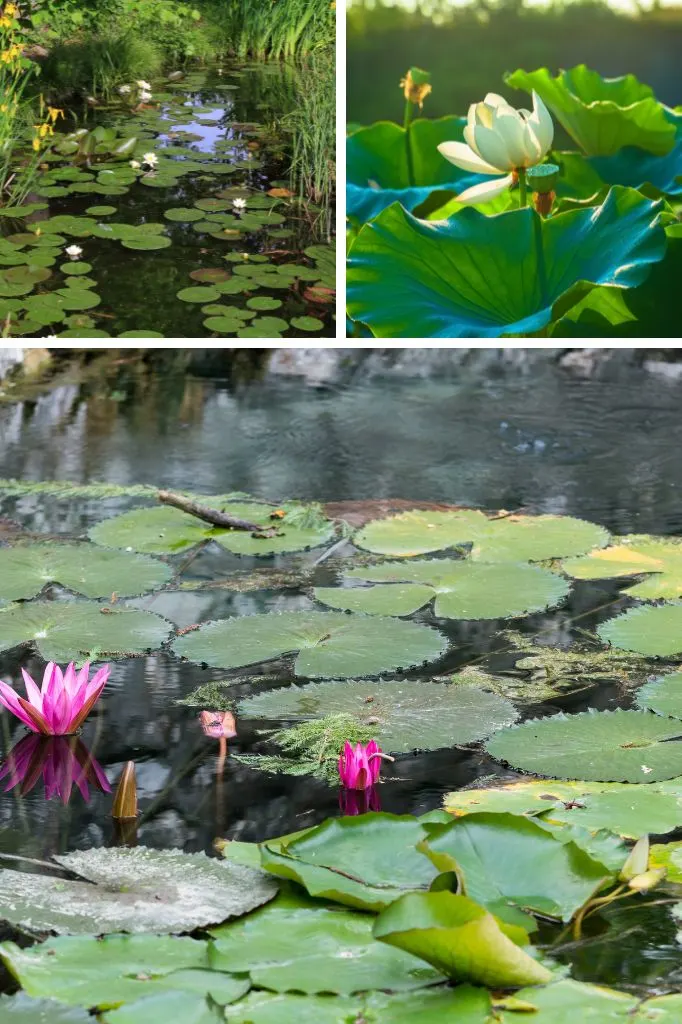
9 Tips for Choosing Plants for Your Pond
1. Selecting Plants for Different Pond Zones
Ponds vary in depth and size, making it essential to choose plants suited for specific pond zones. Marginal plants, which flourish along the water’s edge, are excellent for providing natural filtration and adding aesthetic charm.
They thrive in boggy conditions and can help stabilise pond banks. For those with small ponds or small water features, consider emergent plants like sweet flag (Acorus calamus) or water iris. These plants grow in shallow water and offer fragrant flowers that delight pond owners.
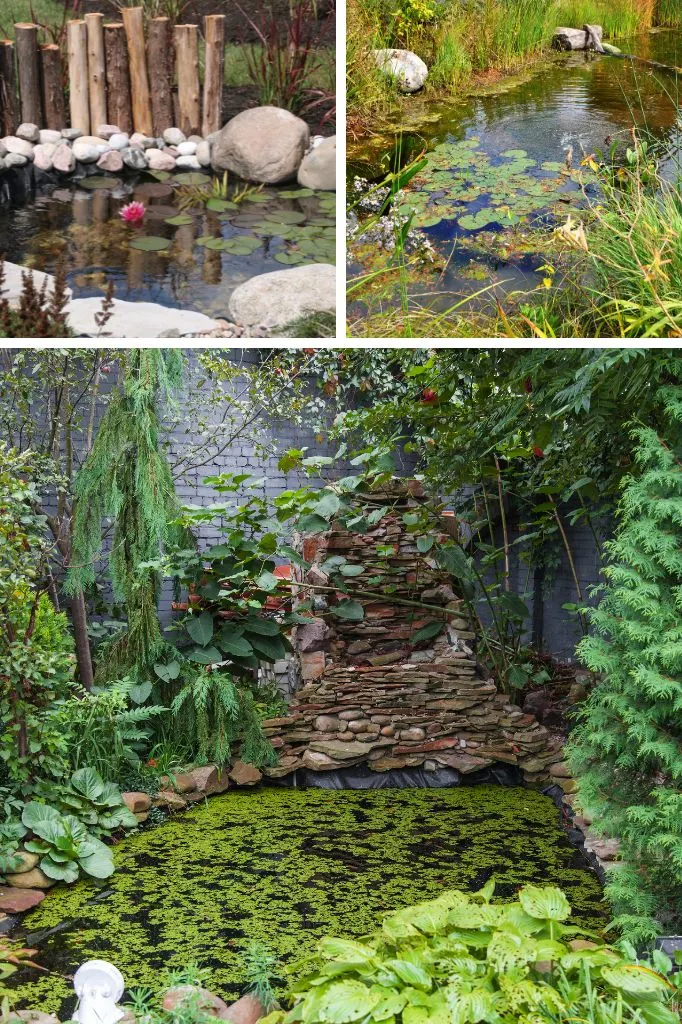
2. Managing Light Conditions
The amount of sunlight your pond receives dictates the types of plants that can thrive. Full sun and partial shade areas offer opportunities for various aquatic plants.
Hardy water lilies are perfect for full sun conditions, with their beautiful flowers gracing the pond surface. In contrast, plants like yellow flag iris thrive in partial shade, adding vibrant colours to your water garden.
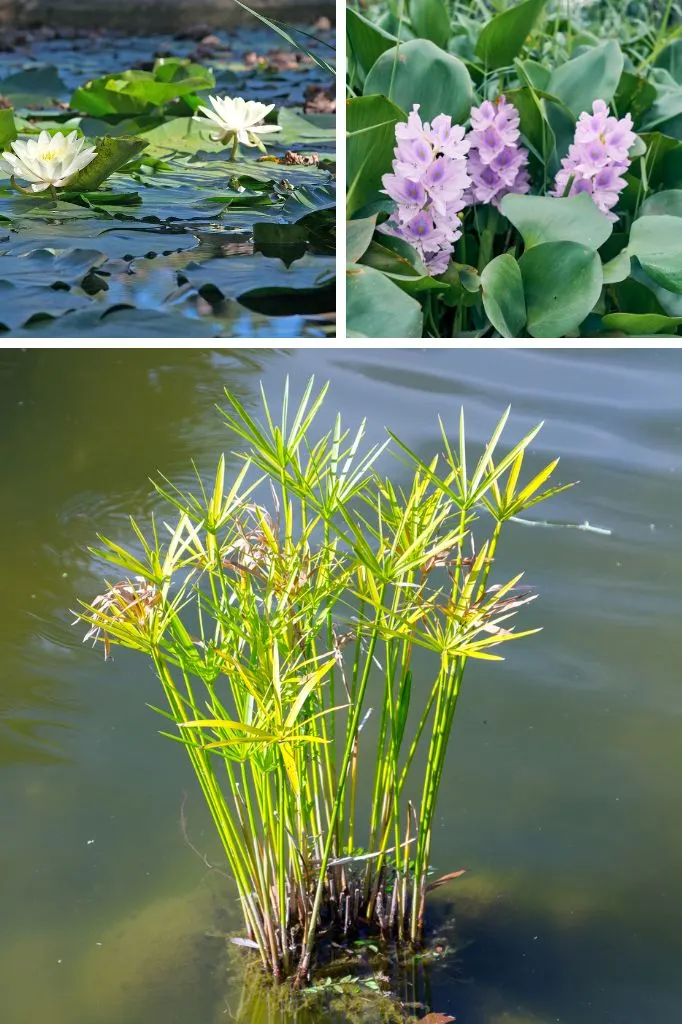
3. Dealing with Invasive Species
While selecting plants, be cautious about introducing invasive species. These aggressive plants can quickly take over and disrupt the balance of your pond ecosystem.
Always choose native species for a harmonious garden pond. Research each plant’s scientific name to verify its status and avoid any unwelcome surprises.
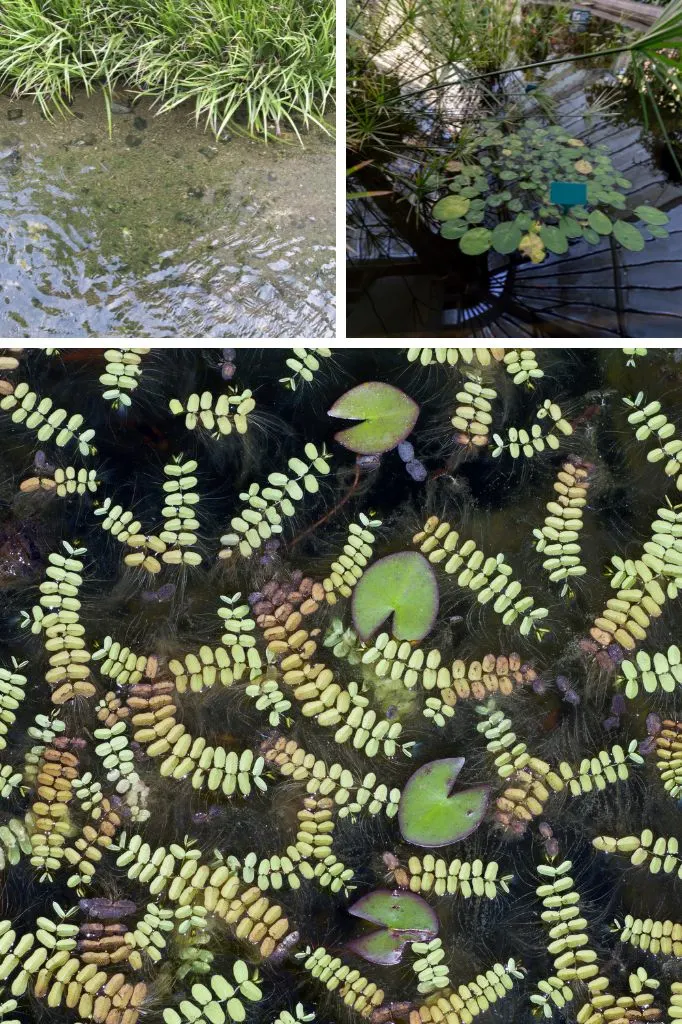
4. Enhancing Water Quality and Oxygen Levels
Aquatic vegetation, such as elodea canadensis (commonly known as waterweed) and water hyacinth, plays a pivotal role in maintaining oxygen levels and water quality. Their presence reduces algal blooms by absorbing excess nutrients, ensuring a clear and healthy pond environment.
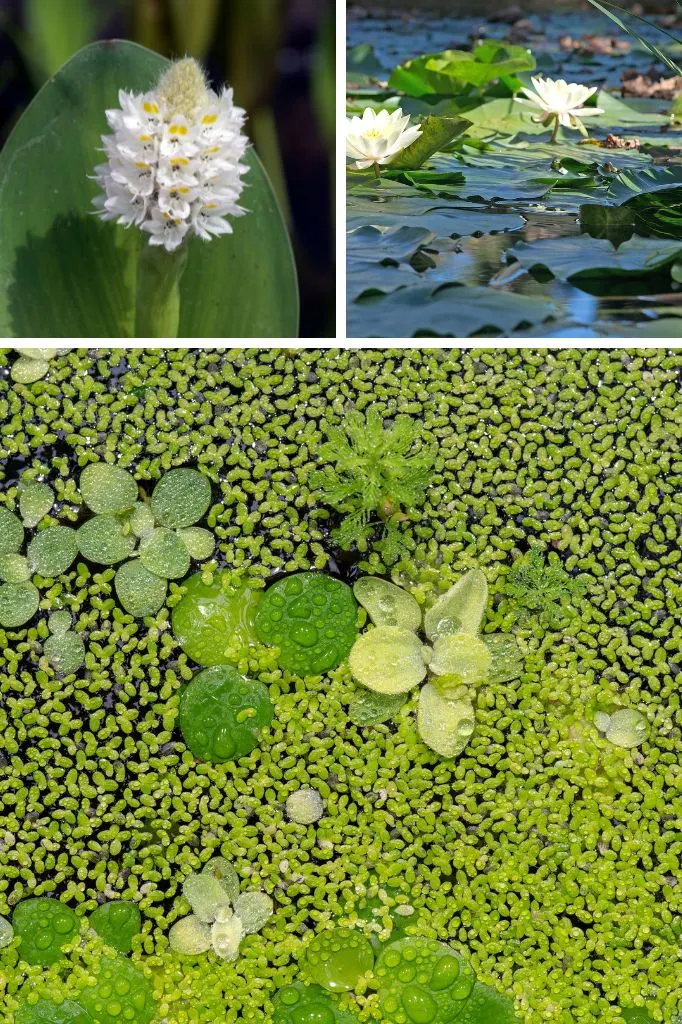
5. Thriving in Different Seasons
Plan your pond plant selection to ensure continuous beauty throughout the year.
Early spring welcomes the first plants, like marsh marigold, which bring a burst of color. As the weather warms in late spring, consider adding purple pitcher plants for a unique touch.
Tropical water lilies are perfect for late summer, as they thrive in warm water and extend the beauty of your pond into the changing seasons.
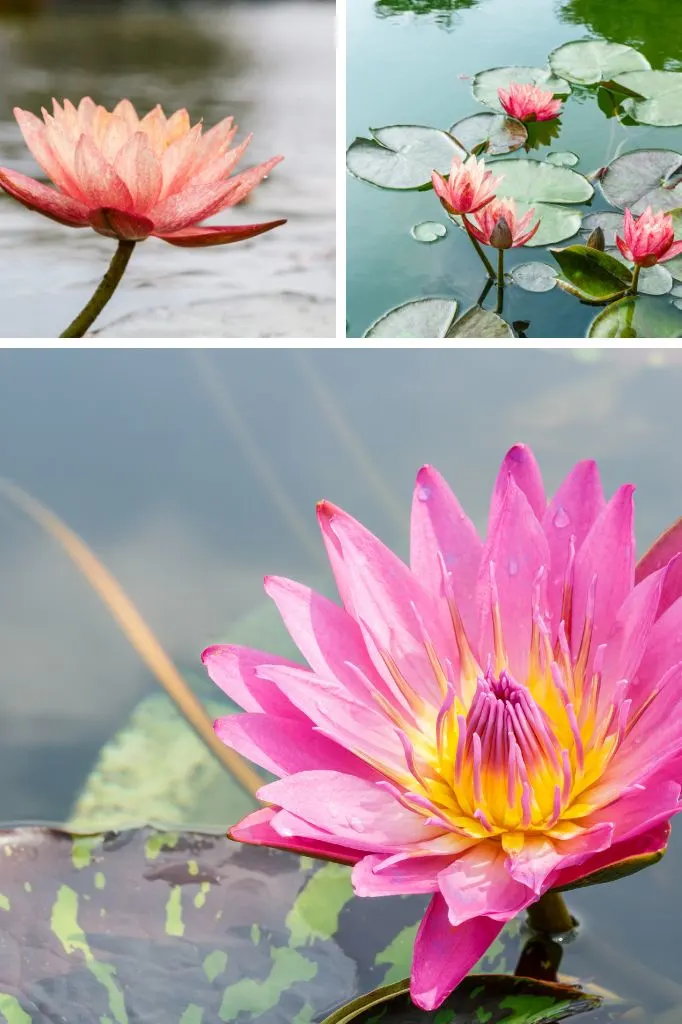
6. Adapting to Different Pond Sizes
Whether you have a small water feature or a larger pond, there’s a plant for every size.
Lotus flowers are exquisite choices for larger ponds, as their tall stems and grand blooms make a striking statement. Dwarf water lilies are ideal for smaller areas, offering the same grace and beauty on a smaller scale.
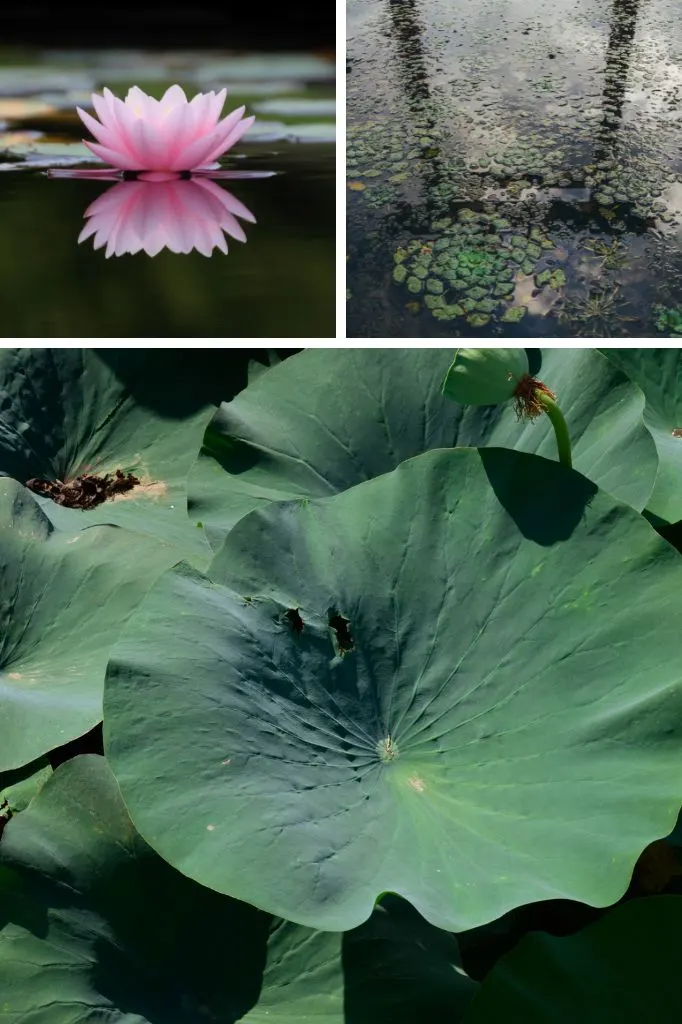
7. Creating a Natural Pond Ecosystem
Introduce a variety of plants to create a self-sustaining pond ecosystem.
Marginal plants provide habitat and shelter for aquatic life, while floating plants like water lettuce and water hyacinth shade the water surface and reduce algae growth. Submerged plants such as Hornwort contribute oxygen and aid in nutrient uptake, fostering a healthy and balanced ecosystem.
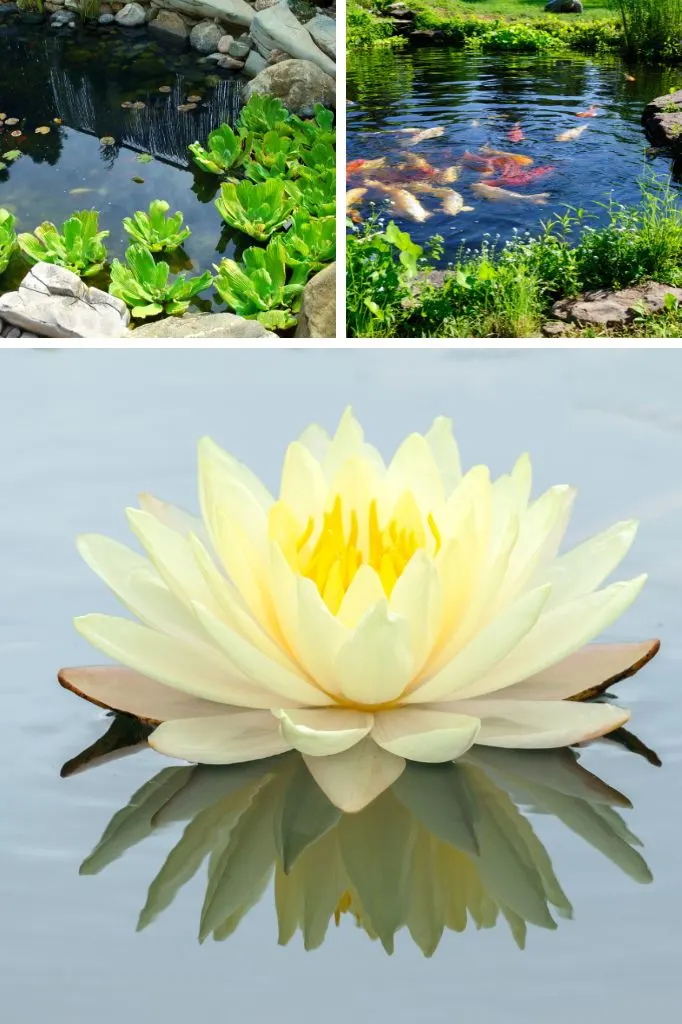
8. Planning for New Ponds
For those setting up new ponds, begin by establishing the right balance of aquatic plants.
Native wildflowers and emergent plants are excellent starting points, providing a foundation for a vibrant and diverse pond ecosystem. Over time, as the pond matures, you can introduce other plant types to serve specific purposes and enhance the enjoyment of the pond.
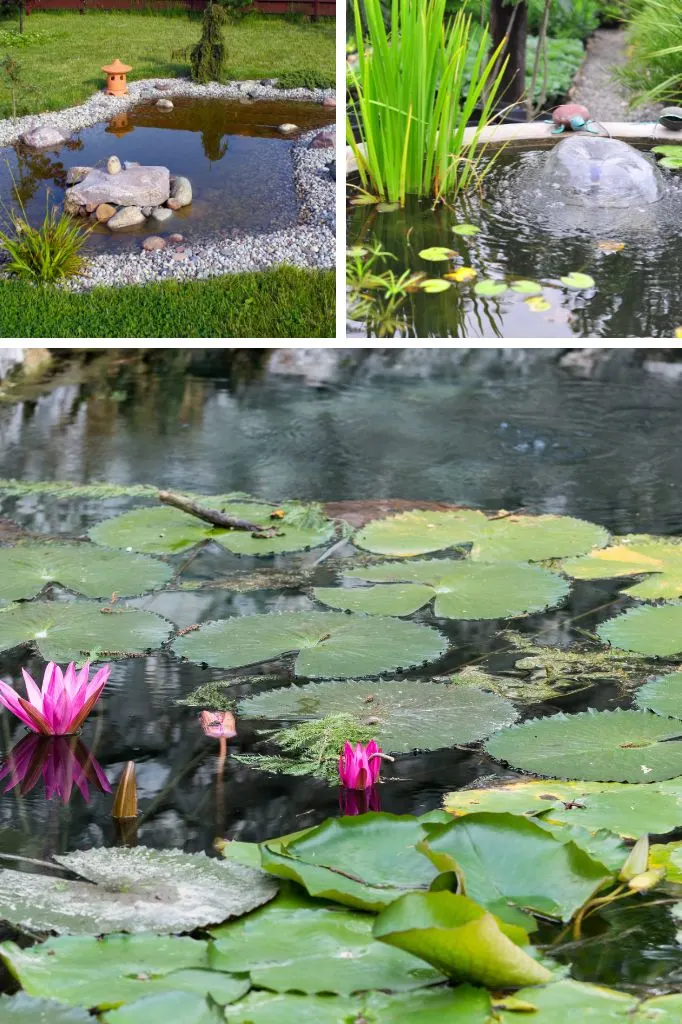
9. Pond Maintenance and Care
Remember that pond plants, like any other garden plants, require proper maintenance. Regularly remove dead foliage and spent flowers to prevent the accumulation of organic matter. Keep an eye on oxygenating plants such as Elodea and Hornwort to ensure they are contributing to the pond’s health. Regular pruning and thinning are necessary, especially for fast-growing plants, to prevent overcrowding.
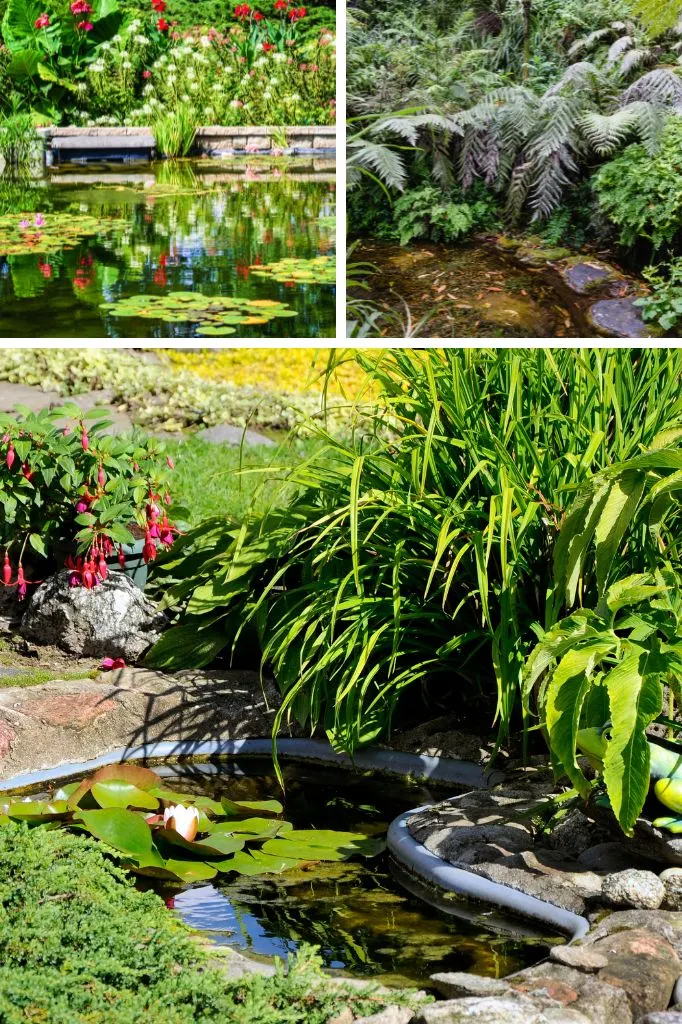
Pond Plants in Folklore: Unveiling Symbolic Meanings
Beyond their beauty and practicality, pond plants have woven themselves into the fabric of human culture and folklore, carrying with them tales of symbolism and meaning. These fascinating stories add an extra layer of enchantment to your aquatic garden.
Water Lilies
In many cultures, the Water Lily symbolises purity, enlightenment, and rebirth. Its ability to emerge from the murky depths to grace the water’s surface has been likened to the journey of the soul. In ancient Egypt, the Blue Lotus, a type of Water Lily, was associated with the sun god Ra and held sacred significance.
Lotus Flower
The Lotus holds deep spiritual meaning across various cultures. In Hinduism and Buddhism, the Lotus represents purity, enlightenment, and spiritual growth. Its growth from the mud, through the water, and into the air mirrors the path of spiritual development.
Cattails
With their tall, striking forms, Cattails often symbolise prosperity, resilience, and endurance. In Native American cultures, they hold a special place, symbolising the unity of earth, water, and sky.
Water Hyacinth
This vibrant plant carries a symbolic message of renewal and new beginnings. Its rapid growth and ability to create a floating habitat exemplify adaptability and resourcefulness.
Yellow Iris
In Greek mythology, the Yellow Iris was associated with the goddess Iris, who acted as a link between the mortal world and the divine. The flower’s vibrant yellow hue is often seen as a symbol of passion and communication.
Marsh Marigold
Known as the “Kingcup” or “Mayflower,” this bright yellow bloom is said to represent creativity and joy. Its appearance in early spring coincides with the rejuvenation of nature after winter.
Water Forget-Me-Not
The name itself evokes a sense of sentimentality and remembrance. These delicate blue flowers symbolise true love and eternal memories.
Water Mint
Mint has long been associated with healing and cleansing. Its presence near your pond not only adds fragrance but also carries the symbolism of rejuvenation and revitalisation.
By understanding the symbolic meanings of pond plants, you can infuse your water garden with deeper layers of significance and connect with ancient traditions. As you cultivate your pond paradise, consider the stories and wisdom these plants carry with them, creating a haven that resonates with both the beauty of nature and the tapestry of human experience.
This post was a list of Plants for Ponds
Thank you for reading my post about plants for ponds. From vibrant water lilies to clever oxygenators, you now have the know-how to create a stunning water paradise.
Remember to match the right plant to your pond’s sun and shade, and be mindful of invasive species. By choosing wisely, you’re crafting a happy home for both plants and critters.


